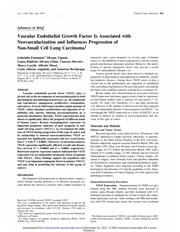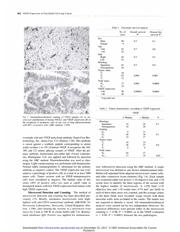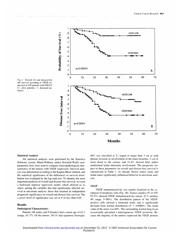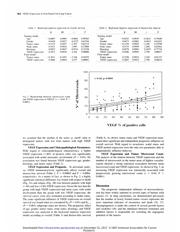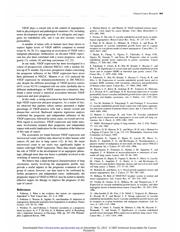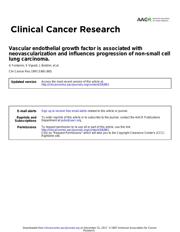Datasheet 搜索 > 微控制器 > Microchip(微芯) > ATTINY861V-10MU 数据手册 > ATTINY861V-10MU 其他数据使用手册 1/6 页

 器件3D模型
器件3D模型¥ 10.867
ATTINY861V-10MU 其他数据使用手册 - Microchip(微芯)
制造商:
Microchip(微芯)
分类:
微控制器
封装:
VQFN-32
描述:
单片机(MCU/MPU/SOC) ATTINY861V-10MU MLF-32(5x5)
Pictures:
3D模型
符号图
焊盘图
引脚图
产品图
ATTINY861V-10MU数据手册
Page:
of 6 Go
若手册格式错乱,请下载阅览PDF原文件

Vol. 3, 861-865, June 1997
Clinical Cancer Research 861
Advances in Brief
Vascular Endothelial Growth Factor Is Associated with
Neovascularization and Influences Progression of
Non-Small Cell Lung Carcinoma1
Gabriella Fontanini,2 Silvana Vignati,
Laura Boidrini, Silvana Chine, Vanessa Silvestri,
Marco Lucchi, Alfredo Mussi,
Carlo Alberto Angeletti, and Generoso Bevilacqua
Department of Oncology. Division of Pathology 1G. F.. S. V.. L. B.,
S. C.. V. S., G. B.l and Department of Surgery, Service of Thoracic
Surgery lM. L.. A. M.. C. A. Al, University of Pisa. via Roma 57.
56126 Pisa, Italy
Abstract
Vascular endothelial growth factor (VEGF) plays a
pivotal role in the development of neovascularization in both
physiological and pathological processes, e.g., developmental
and reproductive angiogenesis, proliferative retinopathies,
and cancers. Several solid tumors produce ample amounts of
VEGF, which stimulates proliferation and migration of en-
dothelial cells, thereby inducing neovascularization by a
paracrine mechanism. Recently, VEGF expression has been
shown to significantly affect the prognosis of different kinds
of human cancer. Because neoangiogenesis represents an
important prognostic indicator of poor prognosis in non-
small cell lung cancer (NSCLC), we investigated the influ-
ence of VEGF during progression of this type of cancer and
its relationship to tumoral neovascularization. VEGF cx-
pression was significantly associated with new vessel forma-
tion (r = 0.44; P < 0.0001). Moreover, in univariate analysis,
VEGF expression significantly affected overall and disease-
free survival (P 0.00003 and P 0.0004, respectively).
Backward stepwise regression analysis indicated that VEGF
expression was an independent prognostic factor in patients
with NSCLC. These findings support the hypothesis that
VEGF is an important angiogenic factor in primary NSCLC
and may help in predicting the outcome of this group of
cancers.
Introduction
Development and progression of human tumors require a
newly formed vascular network ( I . 2 . Because increased vas-
cular density has shown to correlate with a higher incidence of
Received I 1/21/96: revised 2/18/97: accepted 3/3/97.
The costs of publication of this article were defrayed in part by the
payment of page charges. This article must thereftwe be hereby marked
adt’erti.s’eme,ii in accordance with I 8 U.S.C. Section 1734 solely to
indicate this fact.
I This work was supported by grants from the Associazione Italiana per
Ia Ricerca sul Cancro.
2 To whom requests for reprints should be addressed. Phone: 39-50-
592983: Fax: 39-50-592706.
nietastases and a poor prognosis in several types of human
cancer (3). the inhibition oftumor angiogenesis will arrest tumor
growth and decrease metastatic potential. Moreover, the identi-
fication of specific angiogenic factors may provide a useful
target for antineoplastic therapies (4).
Various growth factors have been shown to stimulate an-
giogenesis in physiological and pathological conditions. includ-
ing neoplastic diseases. Among these. VEGF seems to play a
crucial role in the proliferation and migration of endothelial
cells. providing nourishment to the growing tumors and making
the tumorcells establish continuity with the host vasculature (5).
Recent studies have demonstrated an association between
VEGF expression and tumor aggressiveness both in experimen-
tal and human models such as gliomas (6 and gastric (7. 8),
colonic (9), renal ( 10), mammary ( 1 1 ). and lung carcinomas
( 1 2). Because of the number of microvessels has been reported
to be an independent indicator of poor prognosis in NSCLC.3 we
investigated the VEGF expression in a series of NSCLCs in an
attempt to analyze its relation to neovascularization and out-
come of this type of cancer.
Materials and Methods
Patients and Tumor Tissues
Resected specimens were analyzed from 105 patients with
NSCLC submitted to wedge resection, lobectomy, or pneumo-
nectomy at the Santa Chiara Hospital of the Pisa University.
Patients underwent surgical resection between March 1991 and
December 1994. There were 96 males and 9 females (mean age.
62.1; range. 42-77). Follow-up lasted until March 1996. with a
median of S 1 months (range. 2 1-60). Patients had not received
chemotherapy or radiation before surgery. Tumor samples. oh-
tamed at surgery. were formalin fixed and paraffin embedded
for histological exatiiination and immunohistochemical analy-
sis. Tumor fragments were analyzed according to the WHO
histological classification ( 13) and the guidelines of the Amer-
ican Joint Committee on Cancer Staging ( 14 with regard to the
pathological features.
Inimunohistochemical Procedures
VEGF Expression. Immunostaining for VEGF was per-
formed using the ABC method. Sections were dewaxed in
xylene, taken through ethanol, and then incubated with 0.3%
hydrogen peroxide in methanol for 10 mm to block the endog-
enous peroxidase activity. After washing with PBS and incuba-
tion with 10% normal goat serutii, the sections were incubated
The abbreviations used are: NSCLC, non-small cell lung cancer: ABC,
avidin-biotin-peroxidase complex: VEGF, vascular endothelial growth
factor.
Research.
on December 31, 2017. © 1997 American Association for Cancerclincancerres.aacrjournals.org Downloaded from
器件 Datasheet 文档搜索
AiEMA 数据库涵盖高达 72,405,303 个元件的数据手册,每天更新 5,000 多个 PDF 文件
